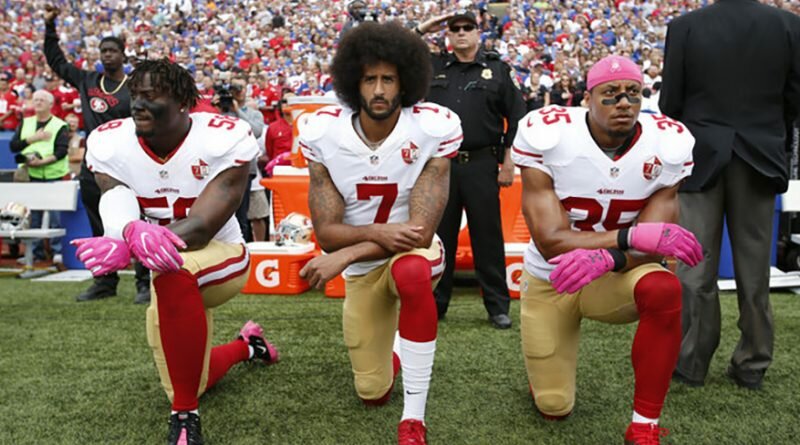Police Killed At Least 223 Black Americans In The Year After Colin Kaepernick’s First Protest
Police and law enforcement officials killed at least 223 black Americans in the year after Kaepernick first began to protest.
The NFL season starts in two weeks, and yet Colin Kaepernick ― the former San Francisco 49ers quarterback who spent the 2016 season kneeling through the national anthem to protest racism and police killings of black Americans ― still doesn’t have a job.
That has sparked debate about whether Kaepernick’s protests are the reason for his continued unemployment, with most evidence suggesting that’s the case. It’s rare for a quarterback who performed as well as Kaepernick did last year to remain without even a backup job, and NFL owners have openly worried about “backlash” from fans who oppose his message.
But as that debate rages on, so do the killings Kaepernick sought to highlight.
Police and law enforcement officials killed at least 223 black Americans in the year after Kaepernick first began to protest, according to a HuffPost analysis of data compiled by The Washington Post and The Guardian.

Kaepernick’s protest became public after a reporter noticed him sitting during the anthem before a preseason game on Aug. 26, 2016. But he had actually started the practice two weeks earlier, before the Niners’ first preseason game on Aug. 14.
Two days after Kaepernick’s initial protest, police in Los Angeles shot and killed 18-year-old Kenney Watkins, a black teenager who, according to officers, was armed with a gun.
Over the next 365 days, as numerous NFL players joined Kaepernick, police across the United States killed at least 222 other black Americans ― culminating with the death, on Aug. 13 of this year, of Patrick Harmon, a 50-year-old black man shot and killed by police in Salt Lake City.
It’s likely that even more black people were killed by police during that time period. The race of the victim has not been identified or confirmed in more than 160 police killings between Aug. 14, 2016 and Aug. 14, 2017, according to The Washington Post’s database, which includes only shooting deaths. The Guardian, which tracked deaths by any method, stopped updating its database at the end of 2016.
Overall, police shot and killed 978 people in the yearlong period that immediately followed Kaepernick’s first protest, according to the Post. Black Americans made up roughly 21 percent of the victims, according to HuffPost’s review.
That finding is in line with previous analyses from the Post, which found that 233 of the 963 people police shot and killed in 2016 were black. As of Wednesday evening, black people had been the victims in 137 of 643 police killings in 2017, according to the Post. Police had also killed 113 other people of color up to that point this year.
African-Americans make up roughly 13 percent of the country’s population ― meaning they are far more likely to die at the hands of police than white Americans, even though more white people are killed by law enforcement overall.
Though many of the victims of police violence were considered armed, according to the Post’s database, others were not. Black Americans are twice as likely as white Americans to be unarmed when police kill them, according to a study released in February.

Kaepernick, whose protest sparked nationwide controversy inside and outside of sports, threw 16 touchdowns against just four interceptions in 12 starts for the 49ers last season. He has been a free agent since he opted out of his contract with the team on March 1 (the 49ers, who went 2-14 last season, would have cut him had he not opted out, new general manager John Lynch said in May).
Police in America have killed at least 84 black people since March 1, the day Kaepernick officially opted out of his contract, according to HuffPost’s review of the two databases on Wednesday evening.
Kaepernick’s protests touched off a wave of activism against police brutality in sports, as players joined in from across the NFL and elsewhere ― including at the high school and college levels. During the offseason, a group of fellow football players visited Congress to discuss police brutality and related issues with federal lawmakers.
Despite Kaepernick’s ongoing absence from the NFL, the protests he helped spark have continued into the 2017 preseason. They’ve even taken on a new significance, thanks to the prominence of recent white supremacist and neo-Nazi rallies across the country.
Seahawks defensive lineman Michael Bennett and Philadelphia Eagles safety Malcolm Jenkins, who joined Kaepernick in protesting during the anthem a season ago, are doing so again. Eagles defensive end Chris Long and Seahawks center Justin Britt both supported their teammates this preseason, becoming the first white NFL players to join the demonstrations. Seattle Reign and U.S. women’s national soccer star Megan Rapinoe, who is white, kneeled during the anthem before her games last year.
Over the weekend, nearly 100 New York City Police Department officers rallied to show solidarity with Kaepernick, the most notable action police have taken to acknowledge his fight against police violence and racial injustice. And on Monday night, 12 Cleveland Browns players kneeled in prayer during the anthem, the largest collective protest the league has seen since Kaepernick began demonstrating a season ago.
On Aug. 15, the day after the one-year anniversary of Kaepernick’s first protest, 37-year-old Herbert “Pop” Gilbert was shot and killed by police in Thomasville, Georgia. Since then, as of Wednesday evening, police had shot and killed at least 21 other people.






